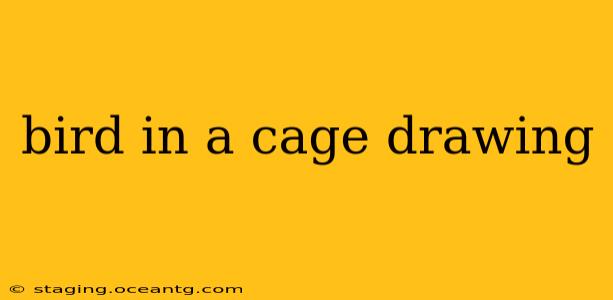Drawing a bird in a cage can be a surprisingly versatile subject, lending itself to a range of artistic styles and emotional interpretations. From a simple, childlike sketch to a detailed, realistic portrayal, the image offers opportunities for exploring themes of freedom, captivity, and the beauty of nature. This guide will explore different approaches to drawing a bird in a cage, catering to beginners and experienced artists alike.
What kind of bird should I draw?
The choice of bird significantly impacts the overall feel of your drawing. A small, delicate finch evokes a different emotion than a large, majestic eagle. Consider the bird's plumage; intricate details like feathers provide a more challenging but rewarding drawing experience. Beginners might find success starting with simpler birds, like a robin or sparrow, before tackling more complex species. Think about the bird's posture too - is it perched, singing, or looking forlorn? This subtly communicates a story.
How do I draw a realistic bird in a cage?
Achieving realism requires careful observation and attention to detail. Start by sketching the basic shapes of the bird and cage using light pencil strokes. Pay close attention to the bird's anatomy – the shape of its head, body, beak, and feet. Gradually add details like feathers, using varied line weights to create texture and depth. For the cage, focus on perspective and the way light and shadow fall on the bars. Consider using different shading techniques, like hatching or cross-hatching, to build form and volume.
How do I draw a simple bird in a cage?
A simple drawing focuses on capturing the essence of the subject rather than minute details. Use basic shapes – circles, ovals, and lines – to construct the bird and cage. Add a few key features like the bird's eye, beak, and tail to make it recognizable. Keep the line work clean and uncomplicated. This approach is ideal for beginners or for creating quick sketches.
What materials should I use to draw a bird in a cage?
The choice of materials depends on your desired style and level of detail. For realistic drawings, pencils (ranging from H to B grades) are a great starting point. You can also use charcoal for a richer, darker tone. For a more expressive approach, try using colored pencils, pastels, or even watercolors. The cage itself could be rendered in a more technical pen and ink style, creating a contrast with the softer bird rendering.
What are some easy steps to draw a bird in a cage for beginners?
- Sketch a basic cage structure: Use simple lines and rectangles to outline the cage.
- Add the bird's body: Use a simple oval or circle for the body.
- Draw the bird's head and beak: Add a small circle for the head and a triangle for the beak.
- Sketch the bird's tail and wings: Use simple shapes to suggest the wings and tail.
- Add details: Add the bird’s eye and simple feather markings.
- Refine the lines: Go over your sketch with a darker pencil or pen, erasing unnecessary lines.
- Add shading: Use shading to give the drawing depth and dimension.
How can I make my bird in a cage drawing more creative?
Don't be afraid to experiment! Try different perspectives, incorporate symbolic elements, or use unusual color palettes. You could depict the bird in a surreal or fantastical setting, or explore different textures and patterns within the cage itself. The possibilities are endless! Consider adding a background that either contrasts with the cage, emphasizing its enclosure, or compliments it, adding a sense of place and context.
What are some common mistakes to avoid when drawing a bird in a cage?
- Ignoring proportions: Ensure the bird and cage are proportionally accurate to each other.
- Over-detailing: Don't get bogged down in minor details, especially as a beginner. Focus on the overall shape and form.
- Neglecting shading and perspective: Shading helps create depth and volume, while perspective makes the cage appear three-dimensional.
- Using only one type of line: Vary your line weight to add interest and texture.
By following these tips and exploring your own creative style, you can create a compelling and unique bird in a cage drawing. Remember that practice makes perfect – the more you draw, the better you'll become!
